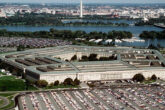April 08, 2024
Stock Buybacks in Defense: What Drives Them, and How That Can Change?
Recent comments by U.S. Navy Secretary Carlos del Toro have reignited a long-running issue of contention between Department of Defense officials and the management of the largest publicly traded defense prime contractors — stock buybacks. Specifically, some senior DOD officials have raised concerns when companies that are doing business with the DOD use remaining capital to buy back existing shares of company stock in lieu of additional investments in research and development, or production capacity.
The secretary is rightly focused on the need for increased investment to facilitate greater innovation and production capacity for strategic competition with China. The management teams of some large defense primes, on the other hand, buy back shares as an efficient way to return value to shareholders after considering the attractiveness of investment opportunities available to the company.
Lack of capital is not a problem hindering investment at the largest defense primes. The issue revolves around the capital allocation decision.
Changing this situation and spurring increased investment in the defense market requires addressing the incentive structures that guide market behavior, including stock buybacks.
Before examining market incentives, it is worth noting that the U.S. government decided many decades ago to largely privatize the defense-industrial base. While the DOD retains a modest number of government-owned arsenals, shipyards and depots, the vast majority of the systems developed and services conducted for the DOD are performed by for-profit companies. These companies have developed the innovations and capabilities that have made U.S. forces the best in the world.
This industrial base includes approximately 200,000 small, medium and large companies, the vast majority of which are privately held. Including those traded on foreign exchanges, there are only about 100 companies that are publicly traded. And only a very small fraction of those companies use share buybacks consistently as a strategic management tool.
Read the full article from Defense News.
More from CNAS
-
The Department of Defense’s Breakthrough Nuclear Moment Risks Slipping Away
Unless they act, the Department of Defense’s breakthrough nuclear moment may vanish before it really happens....
By Will Rogers
-
DEFAERO Strategy Series [Apr 09, 25] CNAS' Becca Wasser and Phil Sheers on Revitalizing the U.S. Defense Industrial Base
On this episode of the Defense & Aerospace Report Strategy Series, sponsored by General Atomics Aeronautical Systems, Becca Wasser and Phil Sheers of the Center for a New Amer...
By Becca Wasser & Philip Sheers
-
From Production Lines to Front Lines
Executive Summary The U.S. defense industrial base (DIB) is struggling to meet the demands of the current strategic environment—let alone prepare for a potential conflict agai...
By Becca Wasser & Philip Sheers
-
The Pentagon’s Endangered Brain Trust
In this environment, sound assessments of emerging threats and new ideas to counter them will be especially vital....
By Dr. Andrew Krepinevich, Jr.




